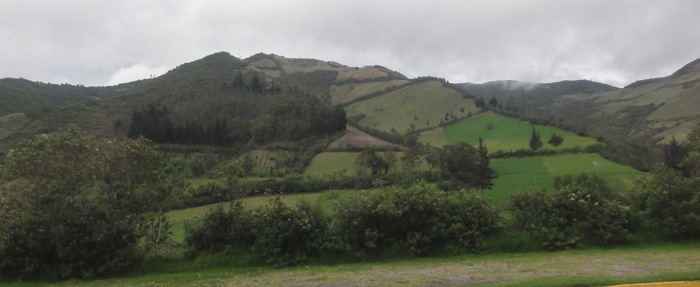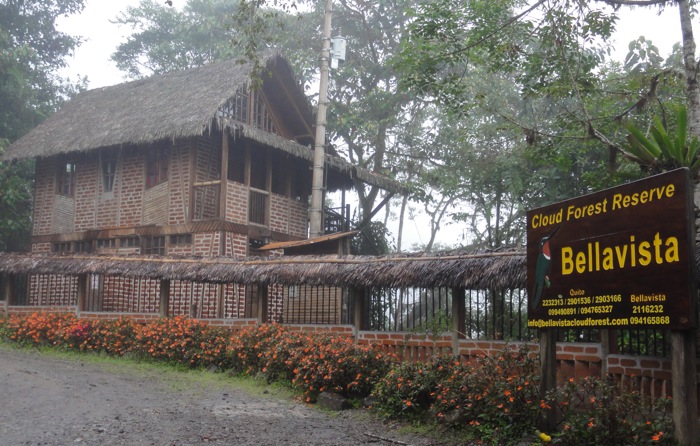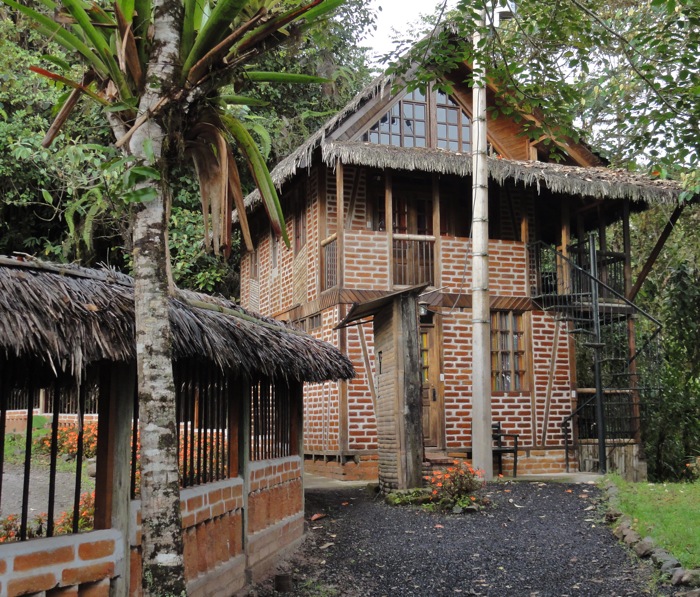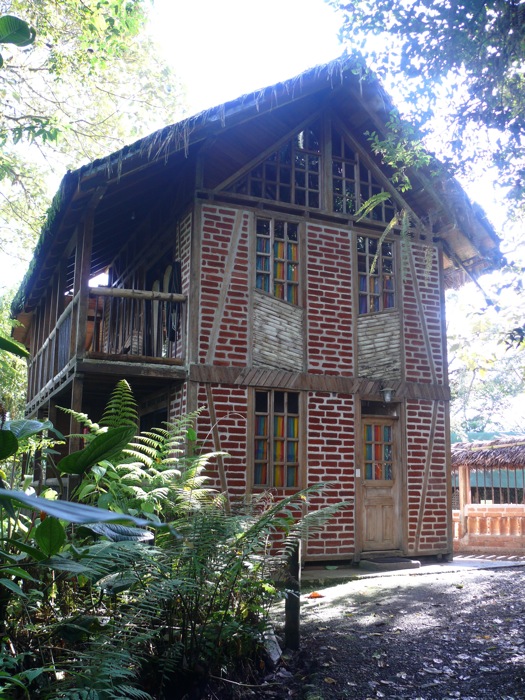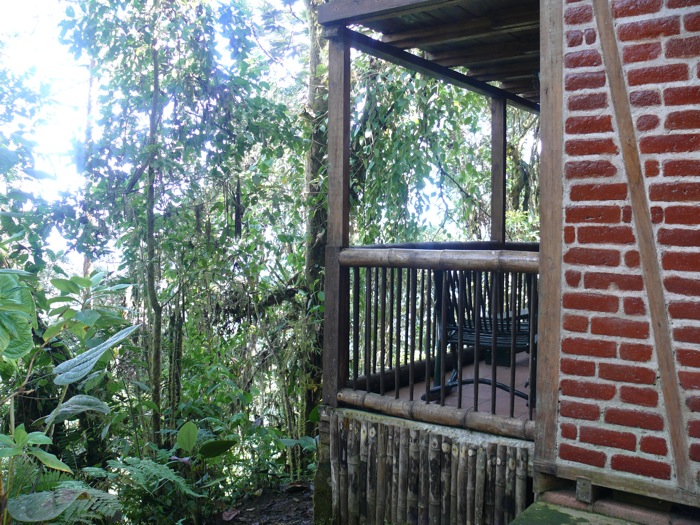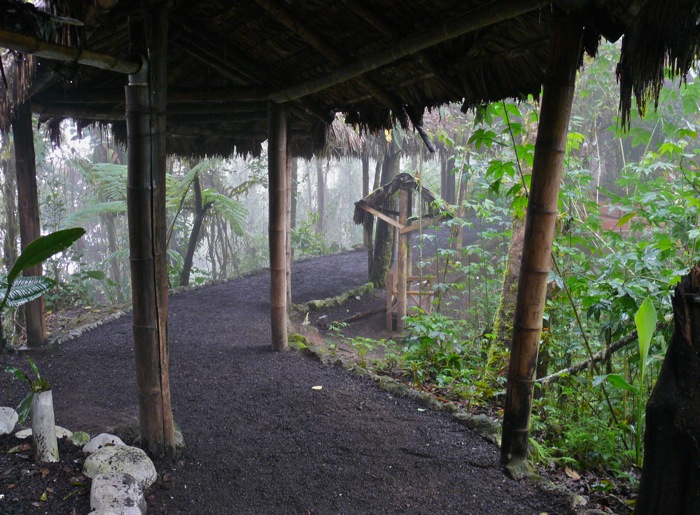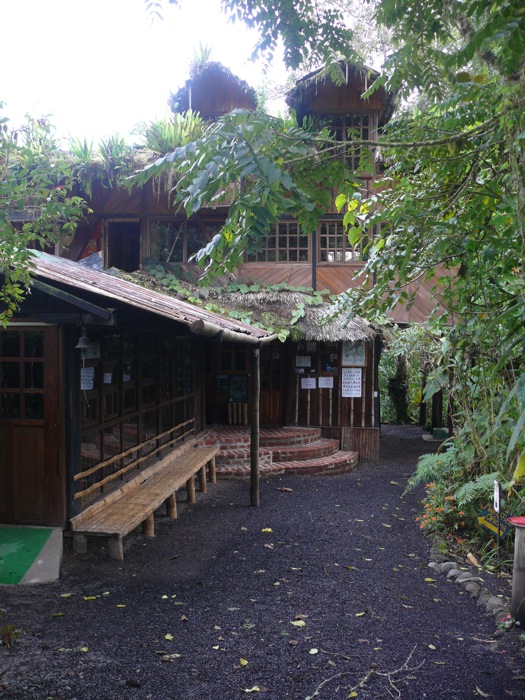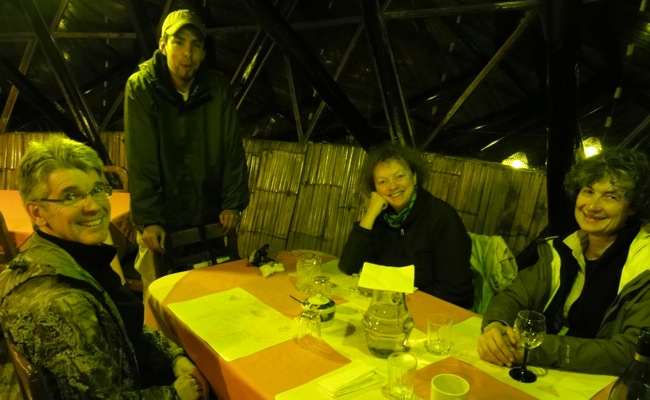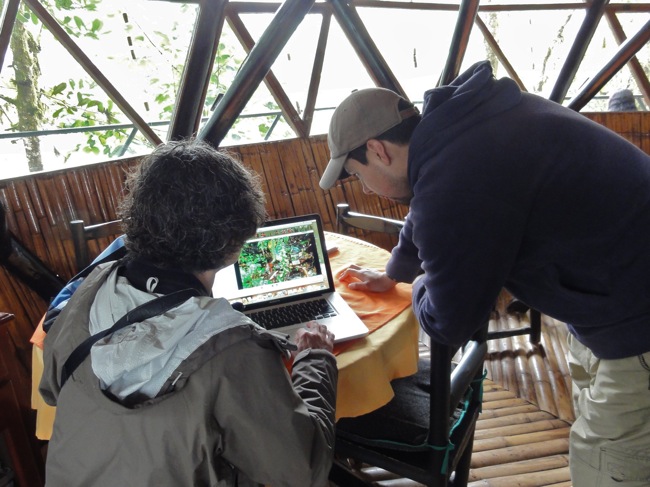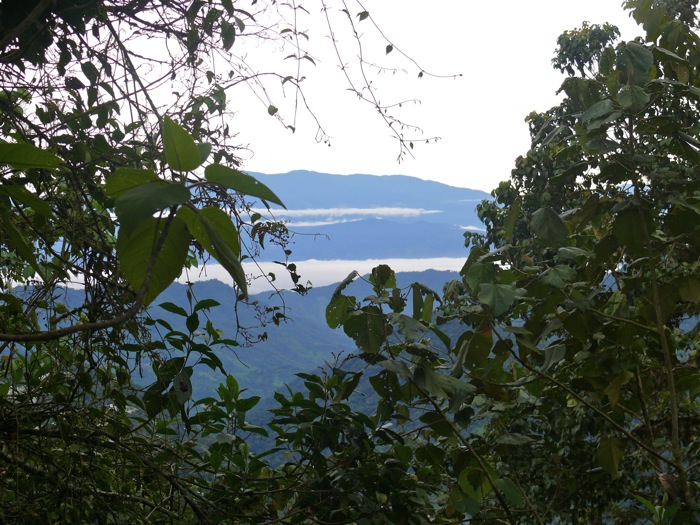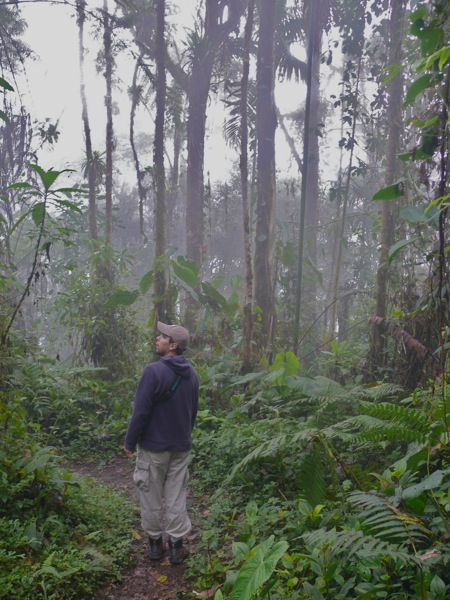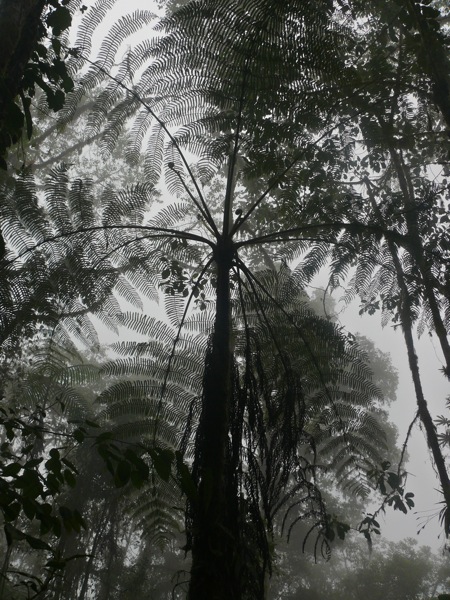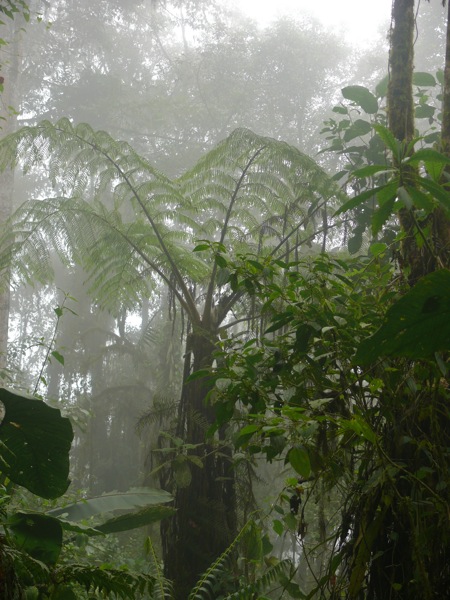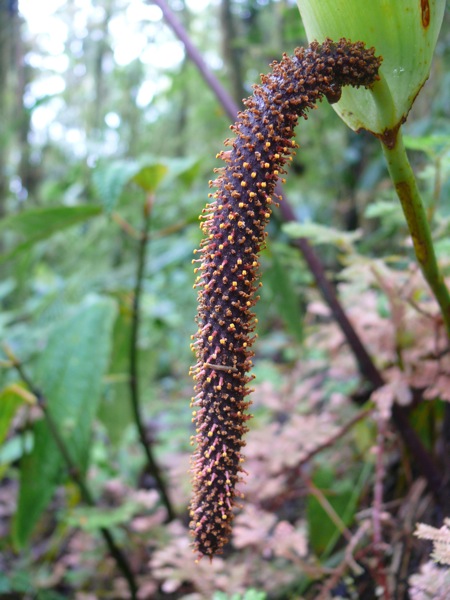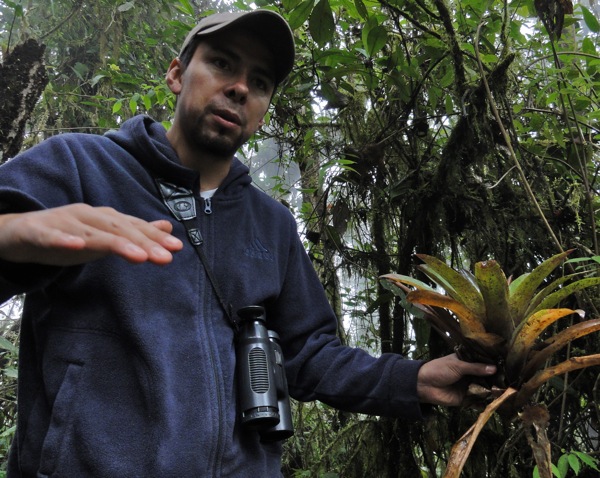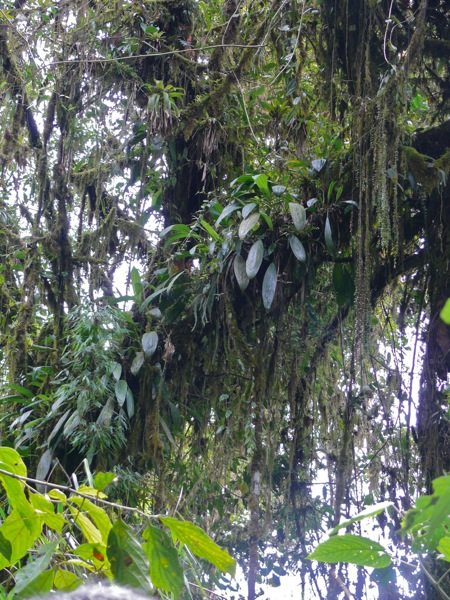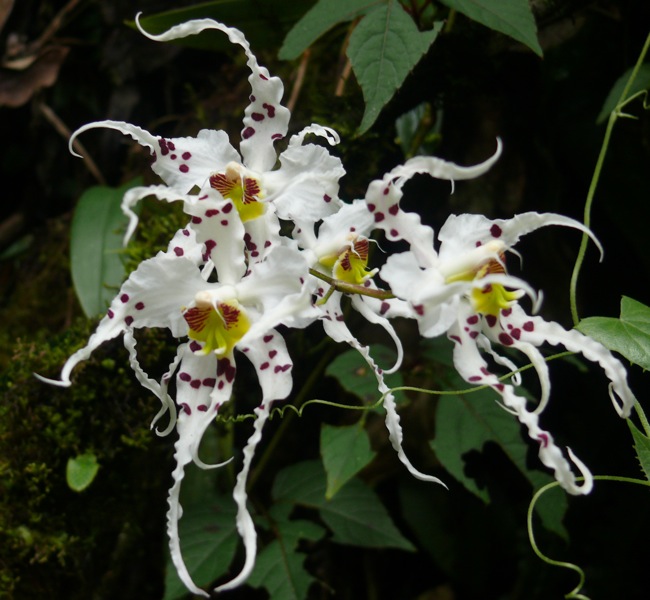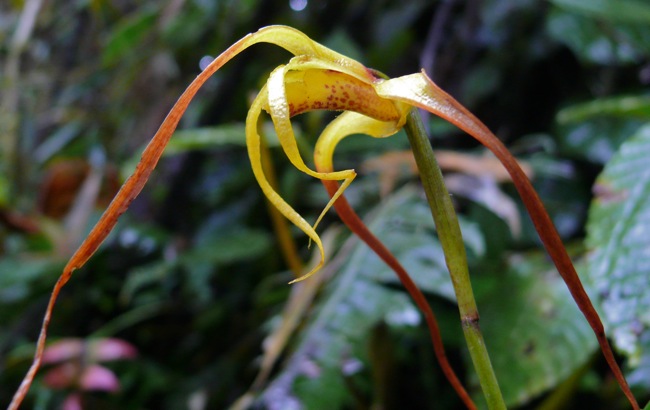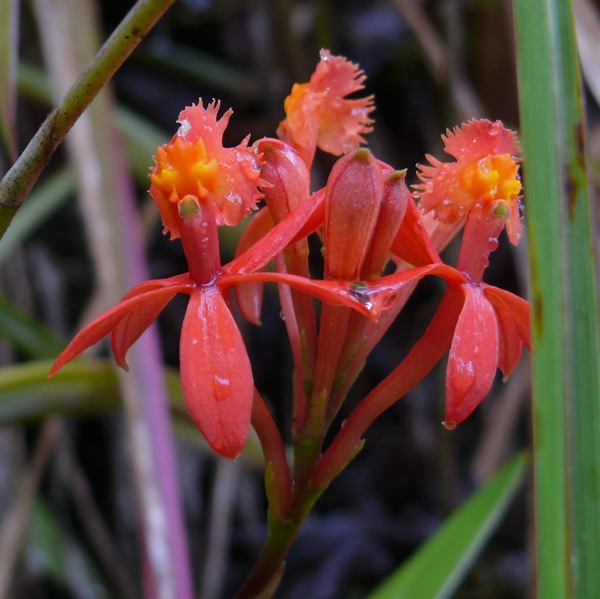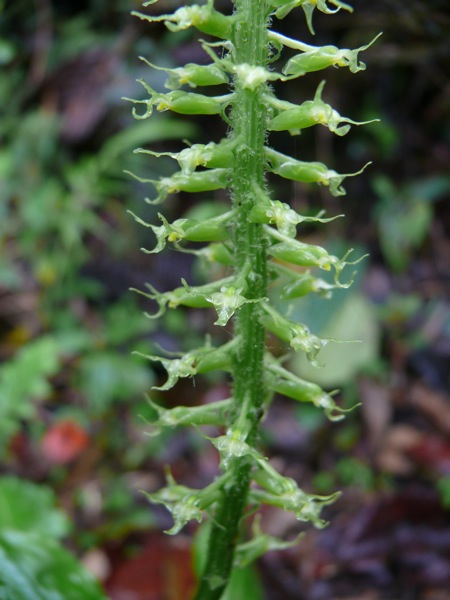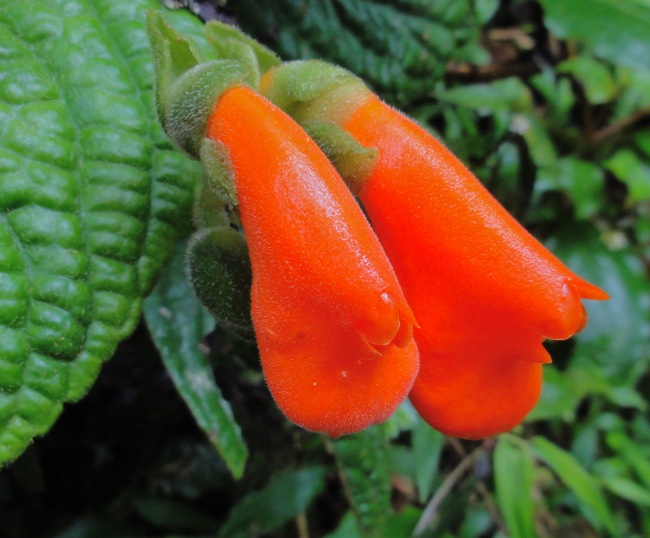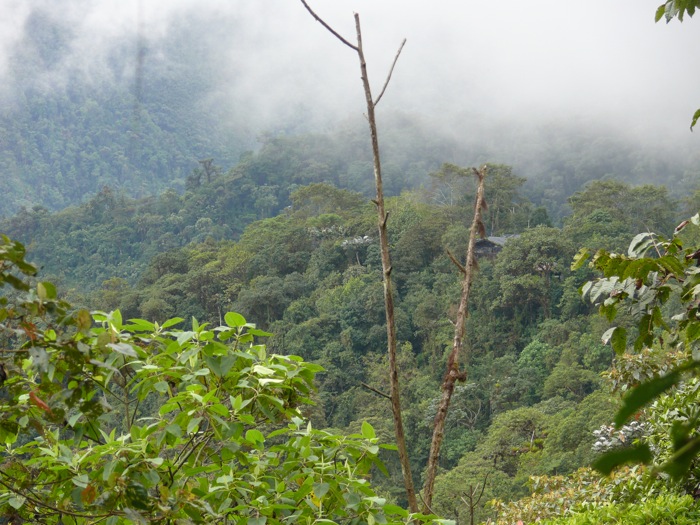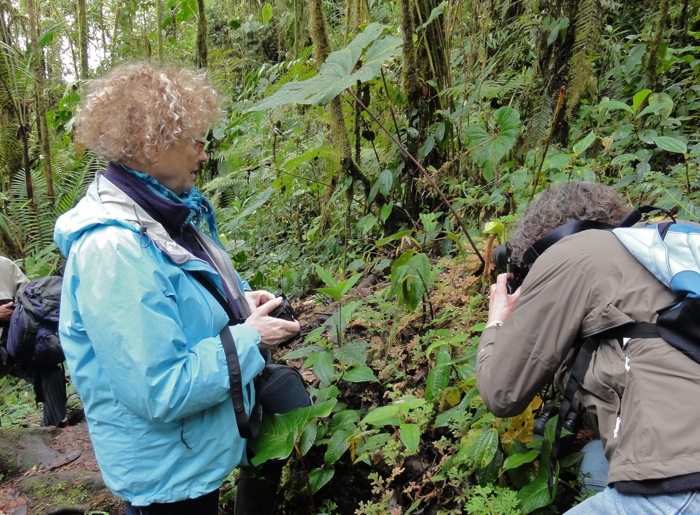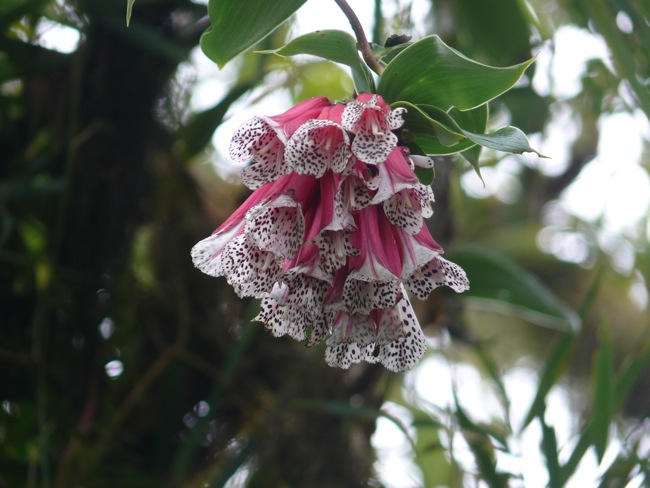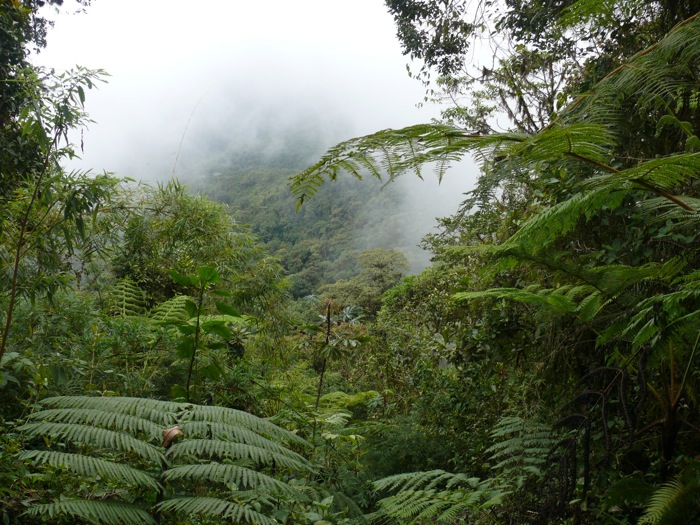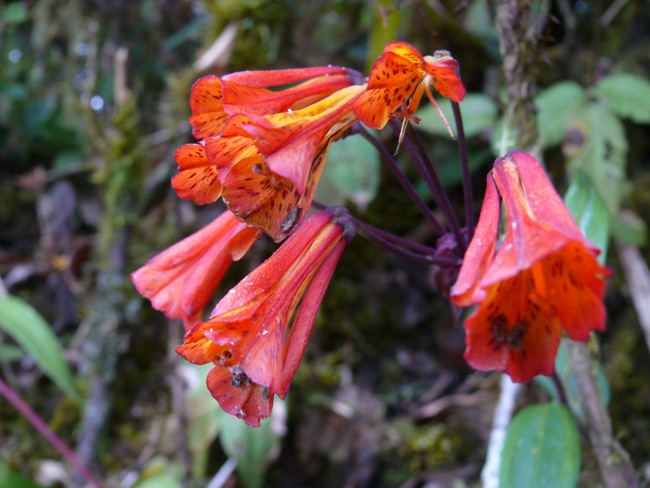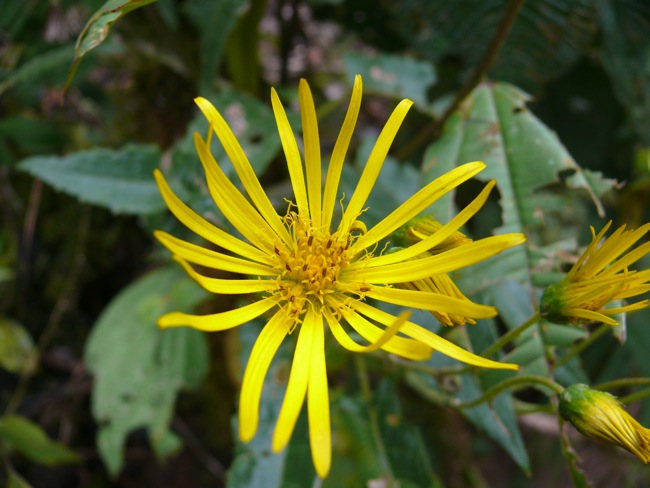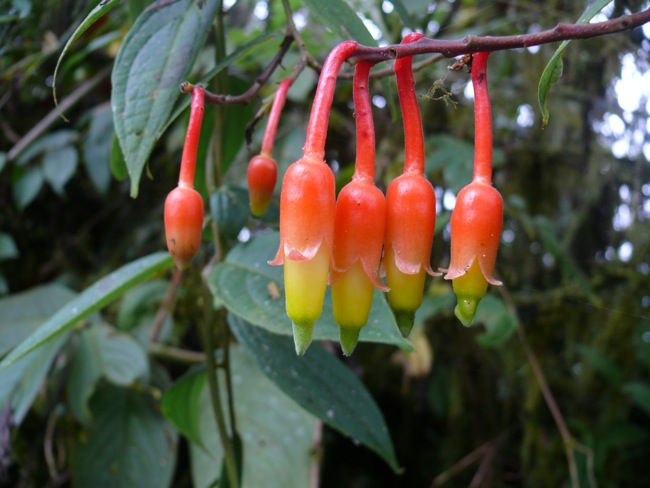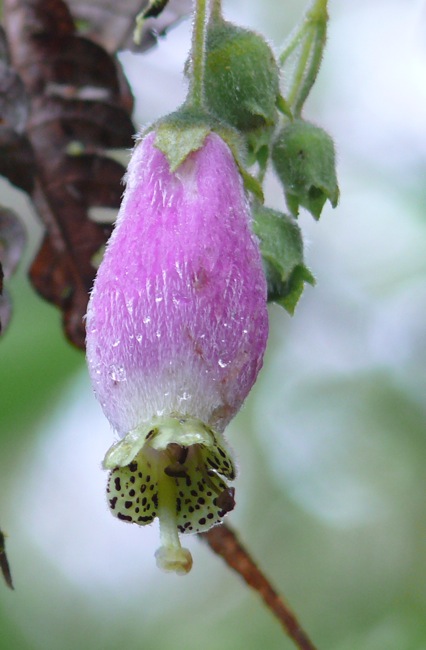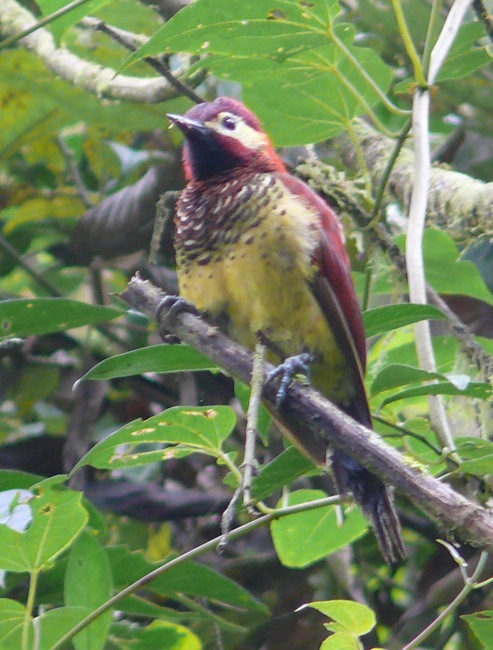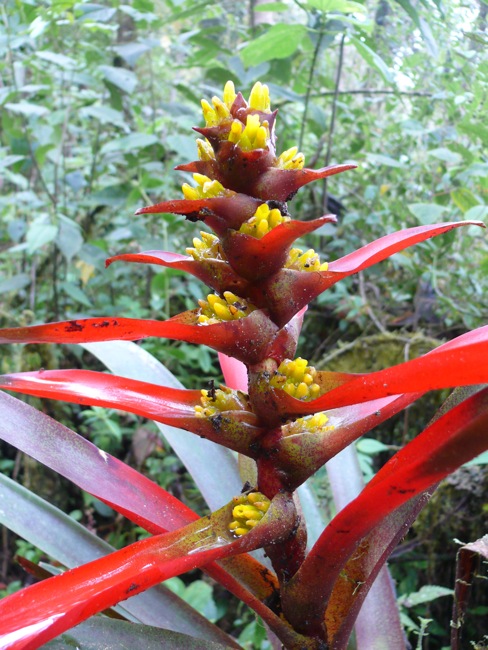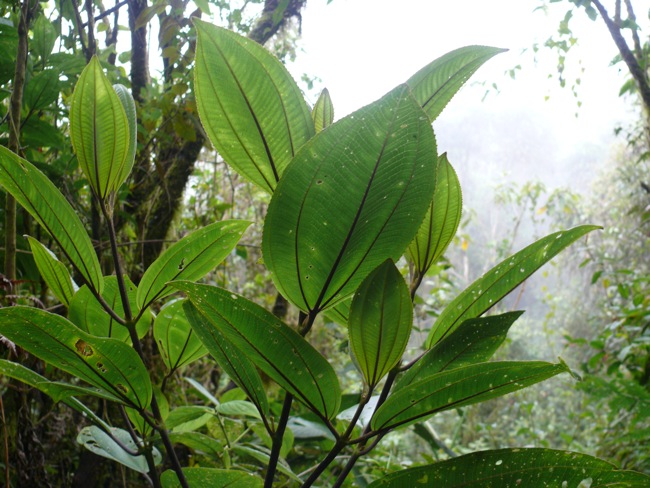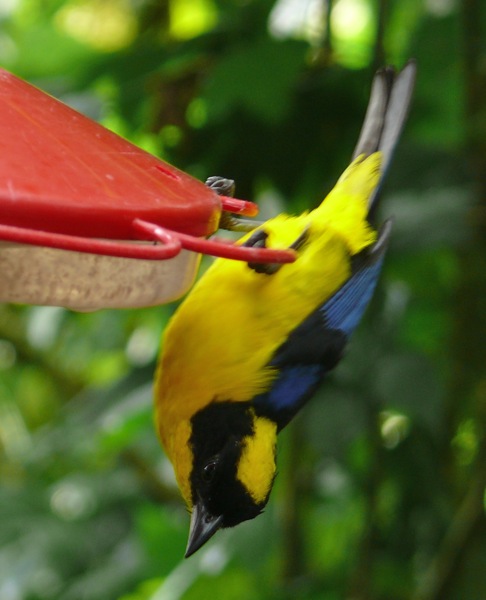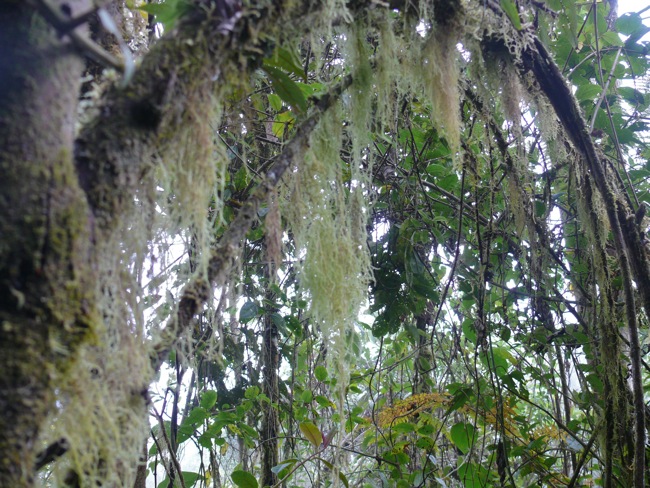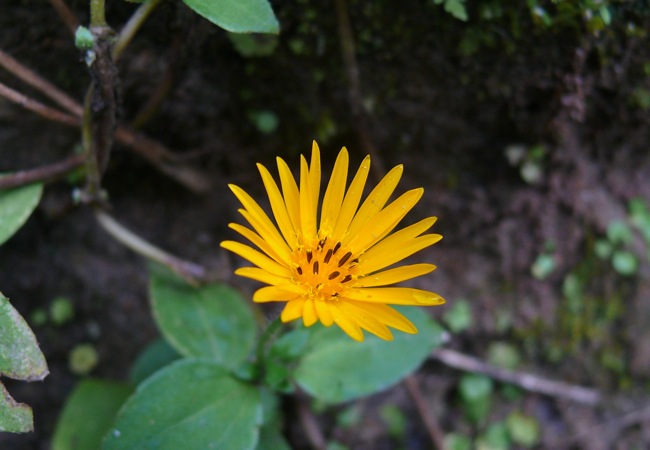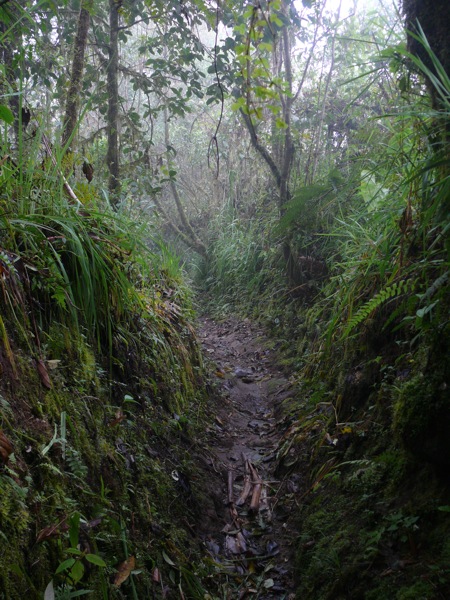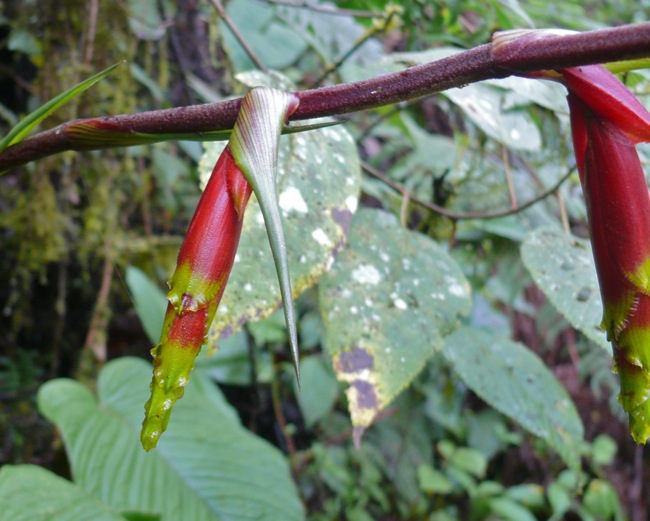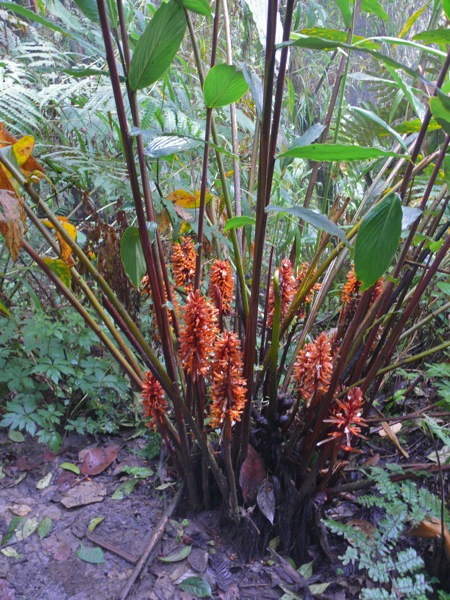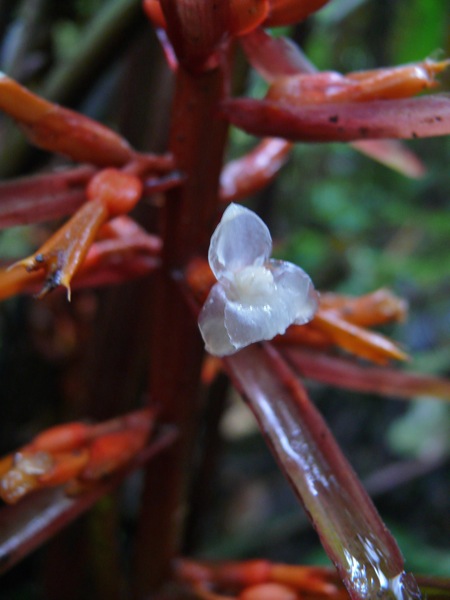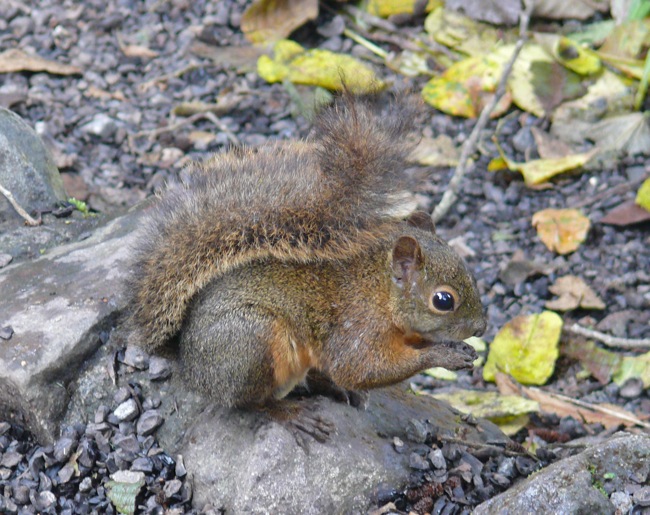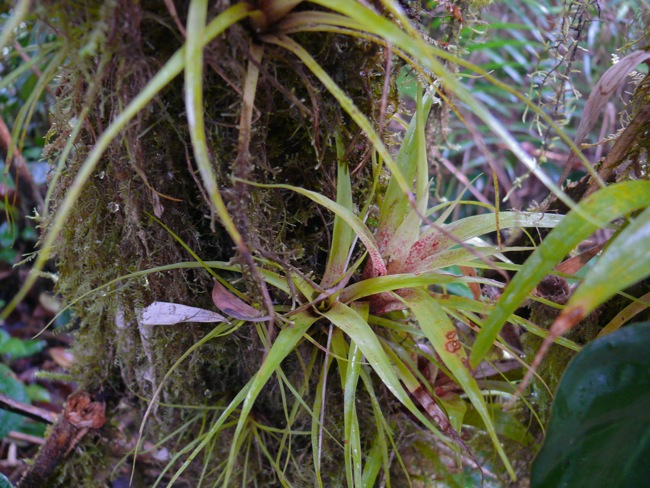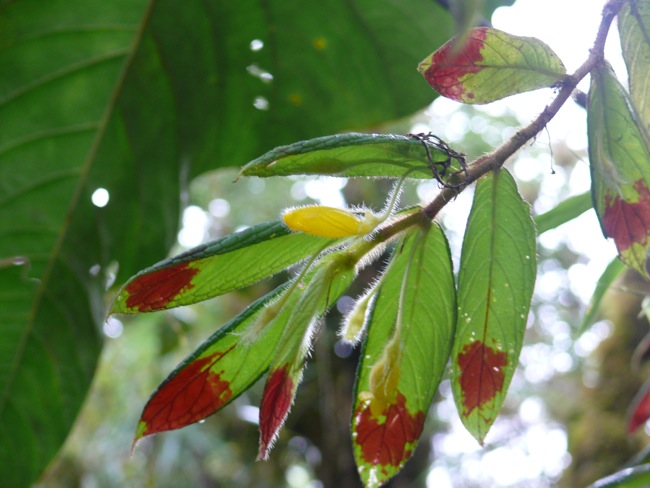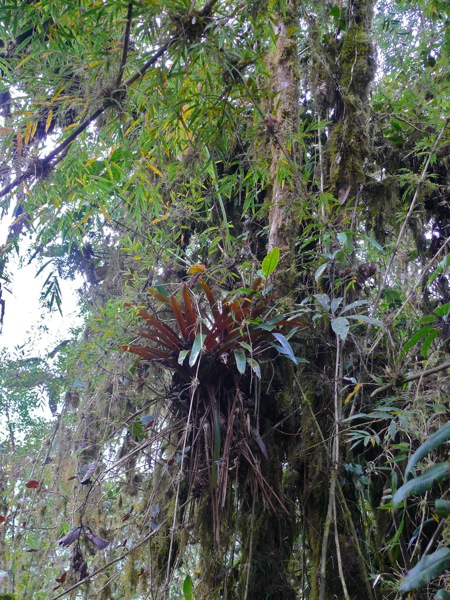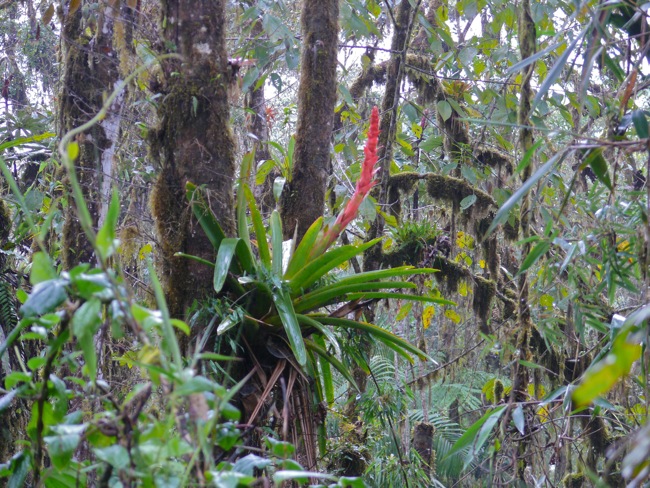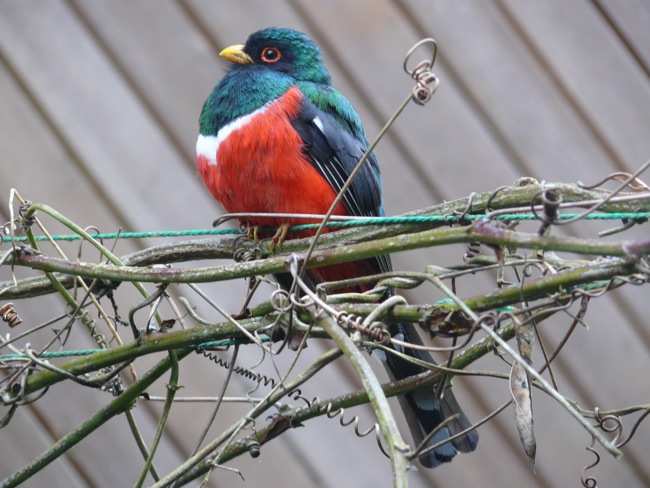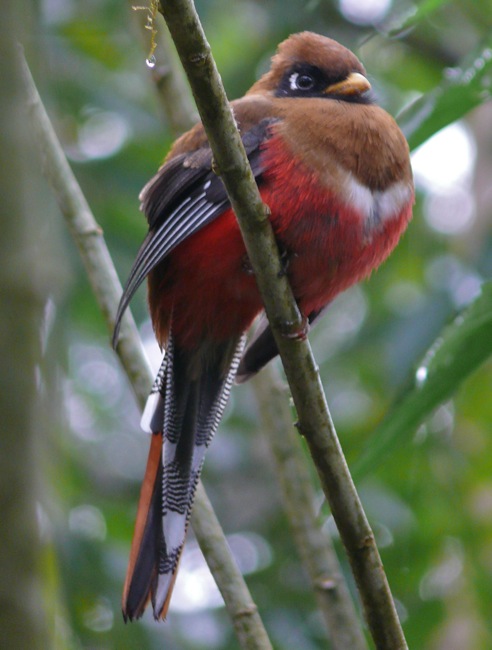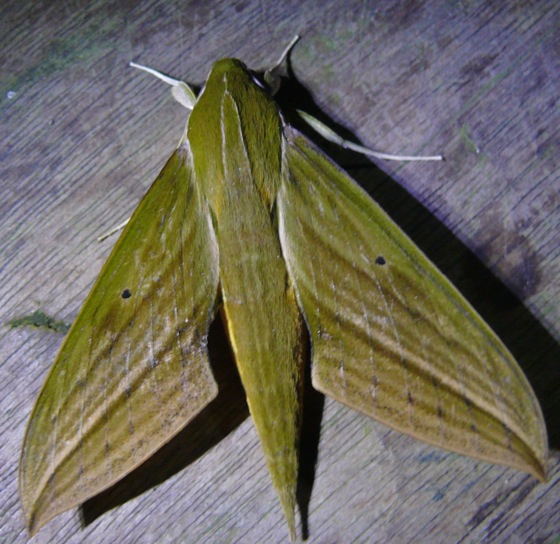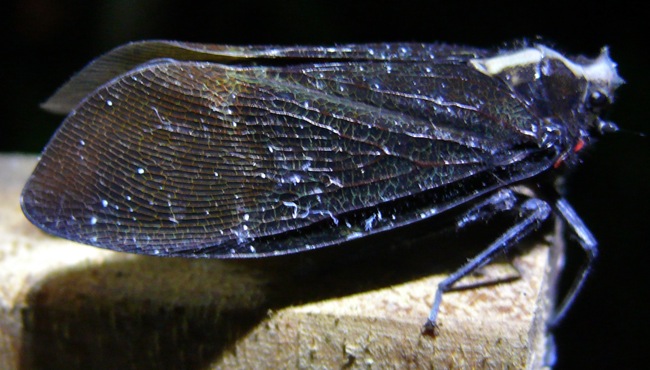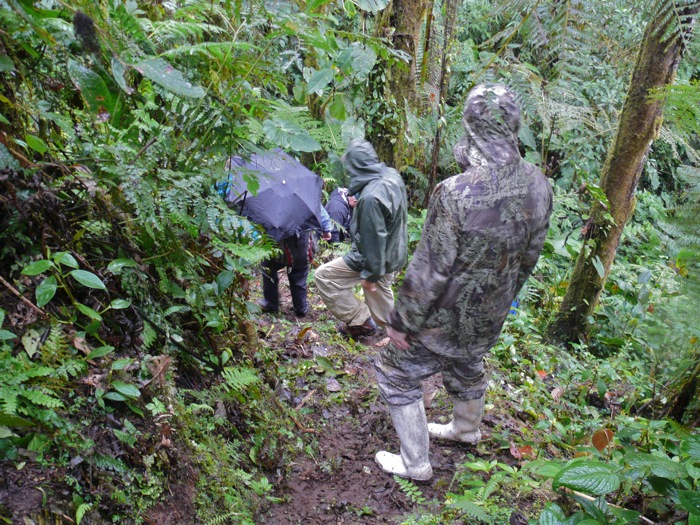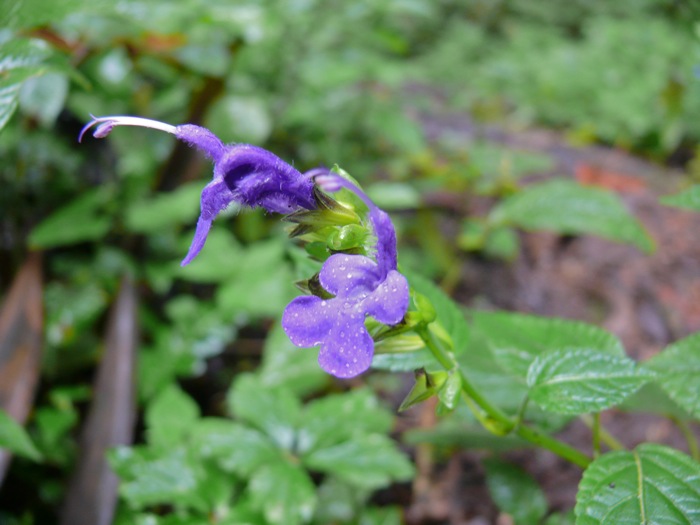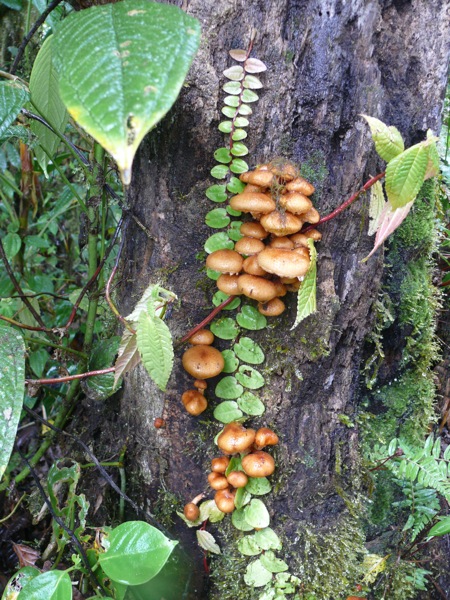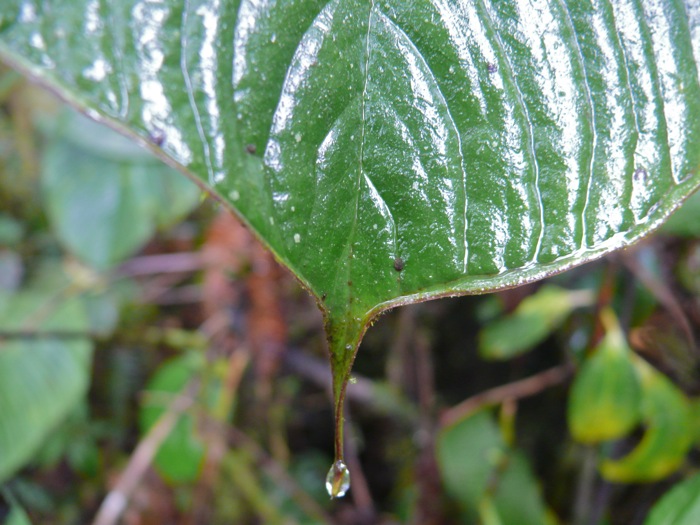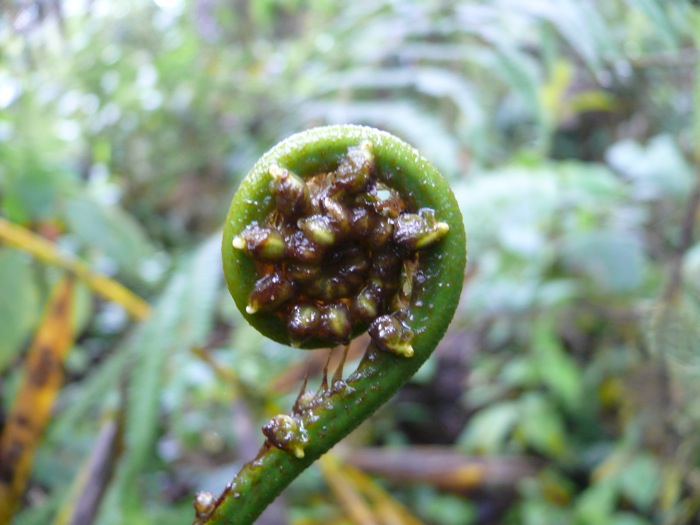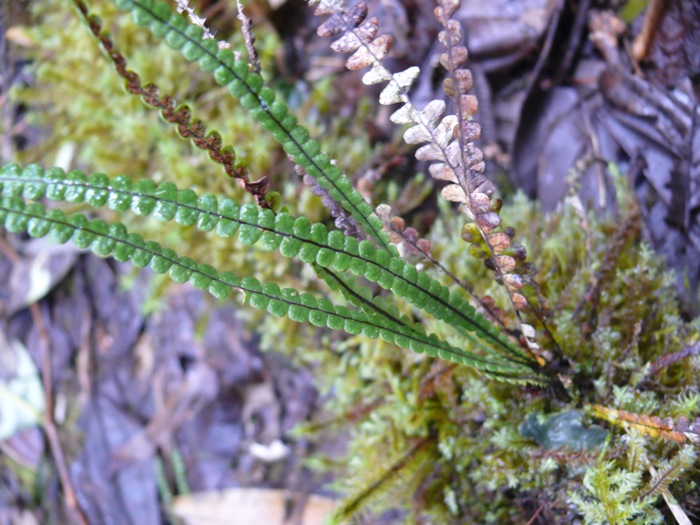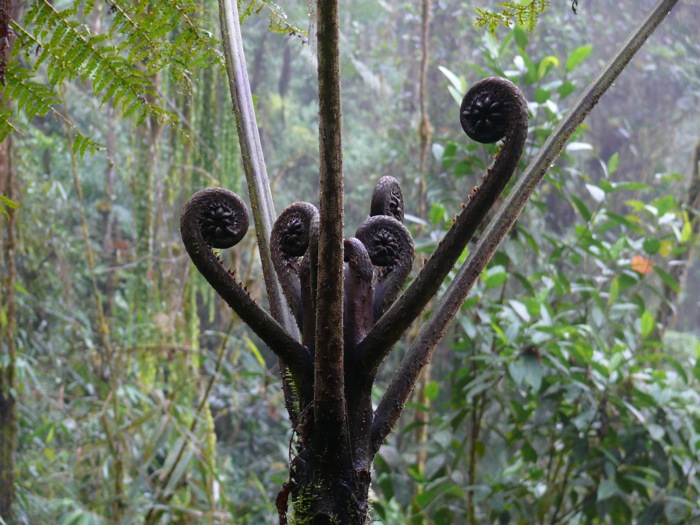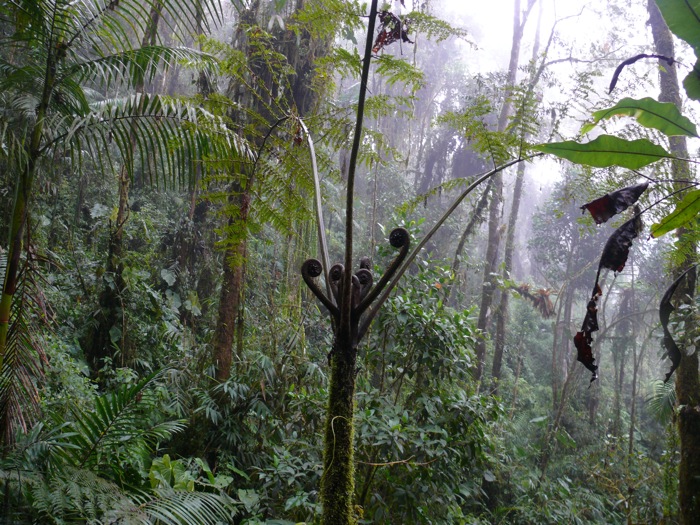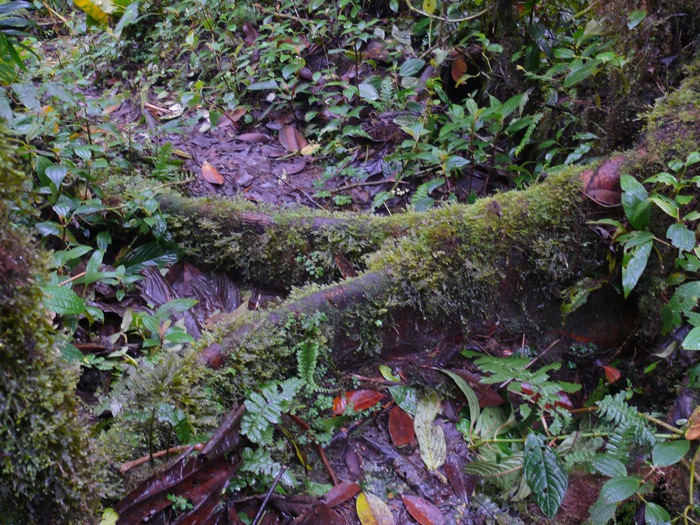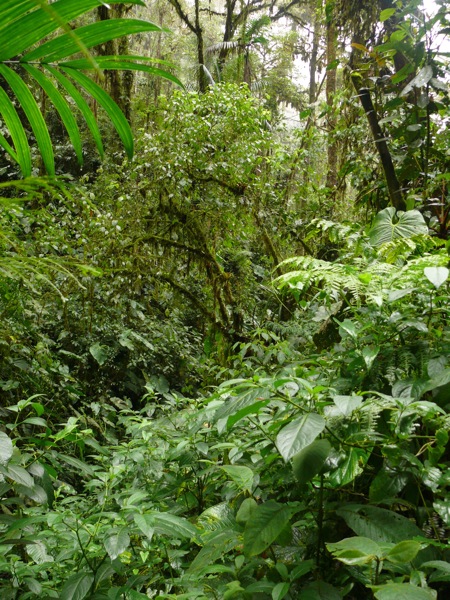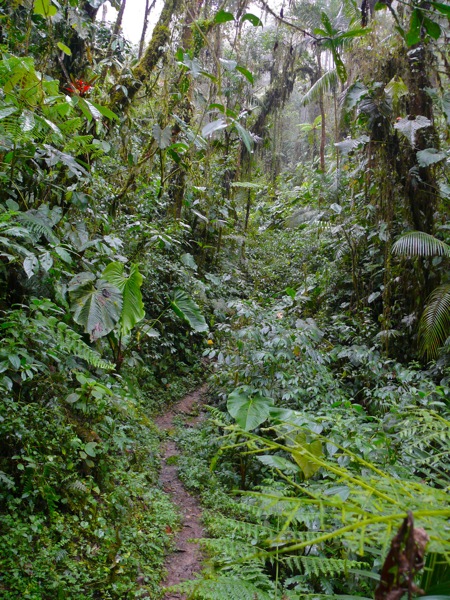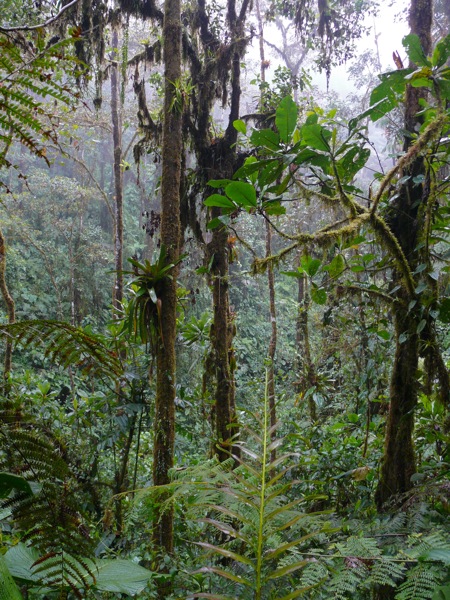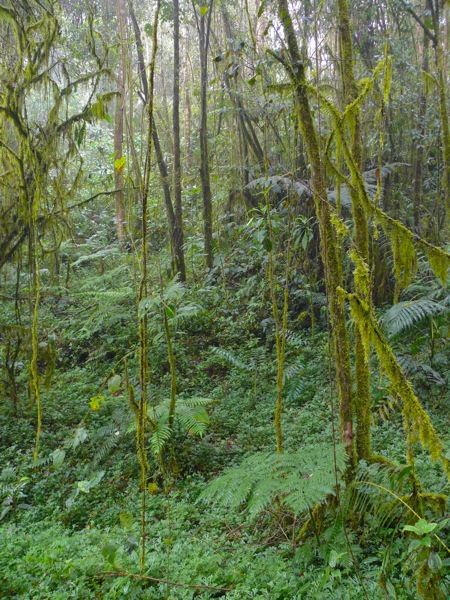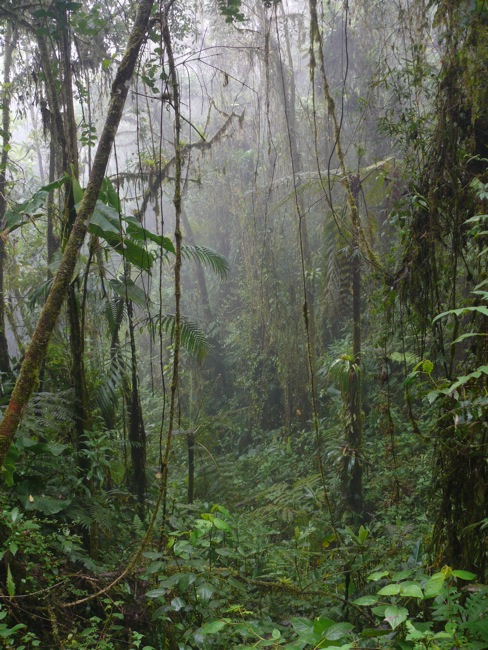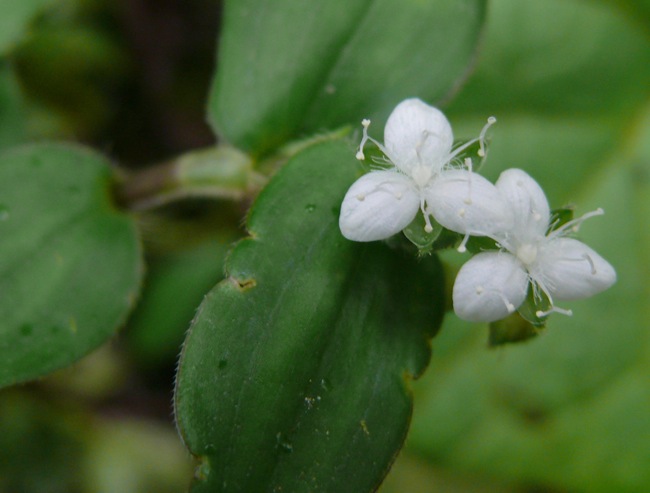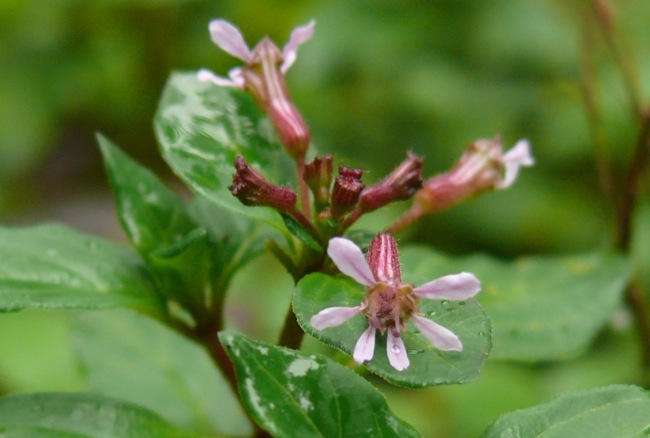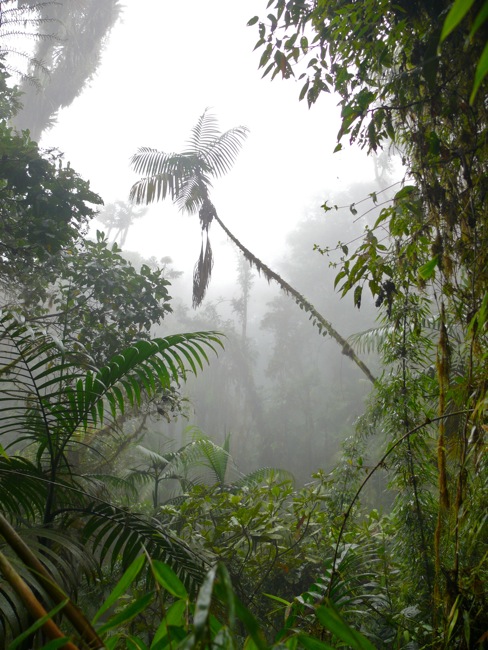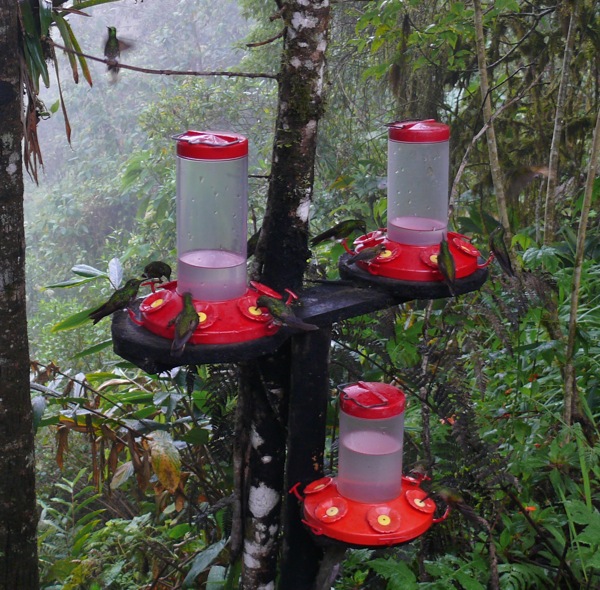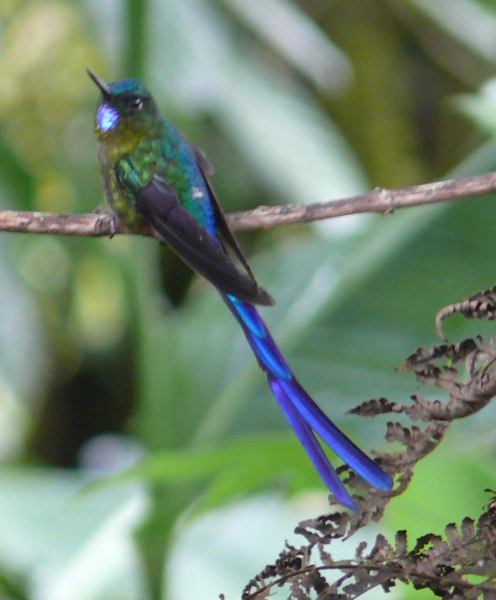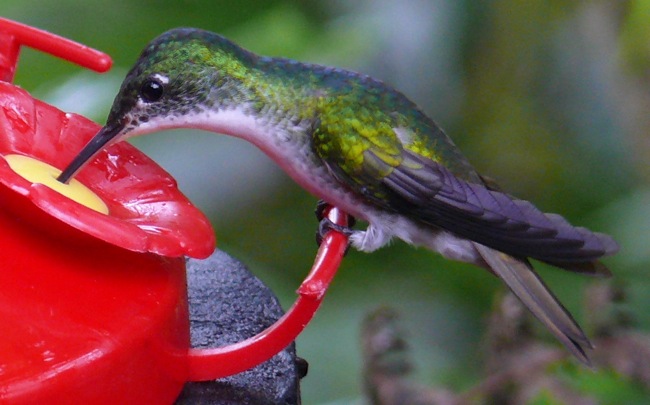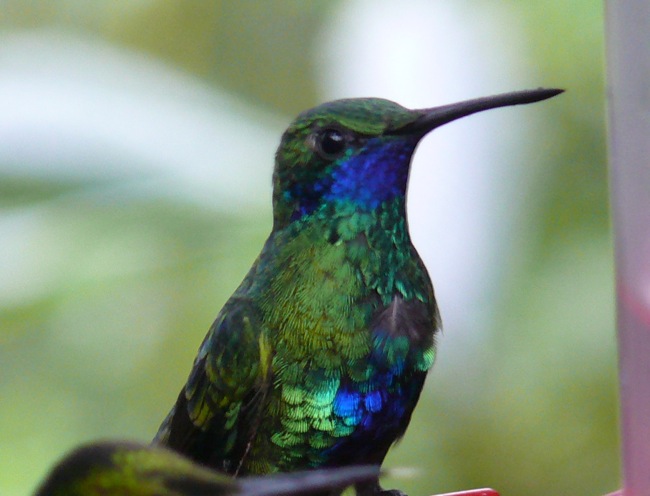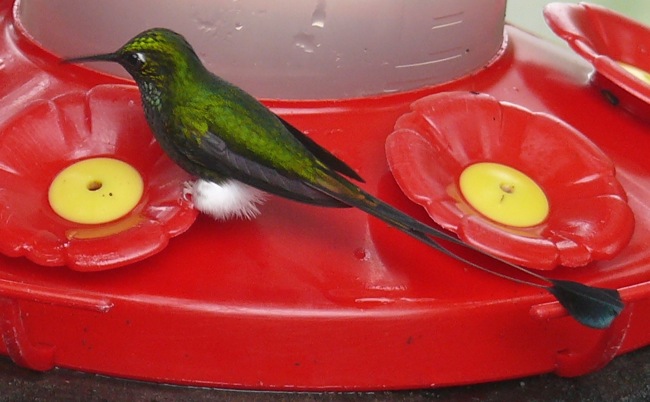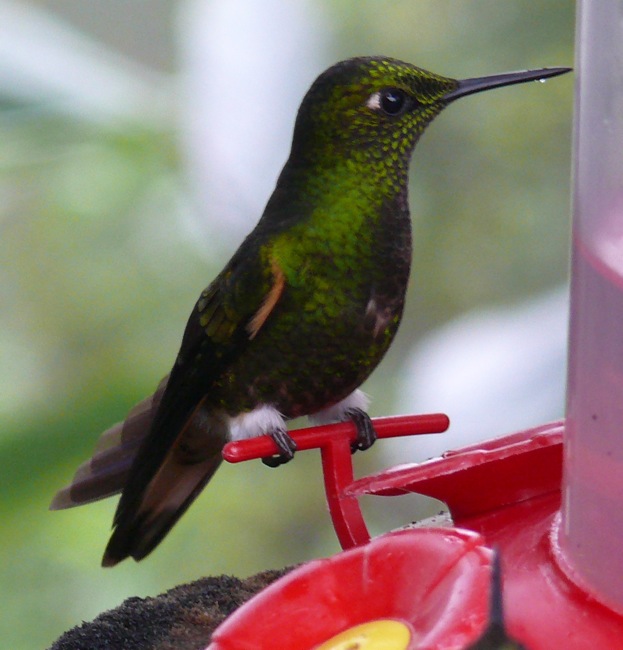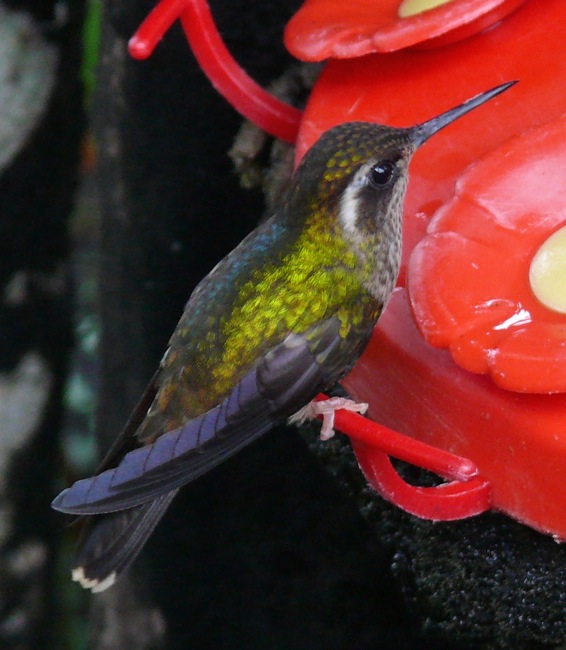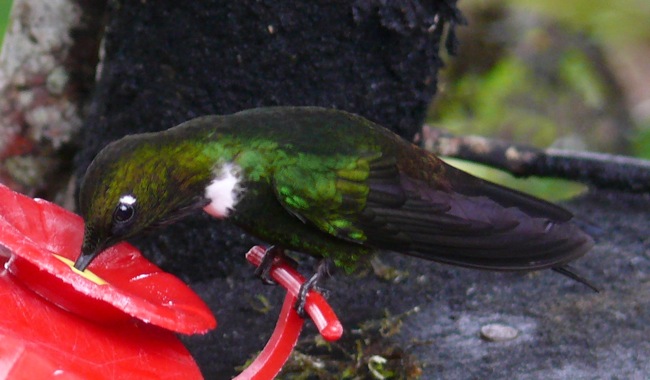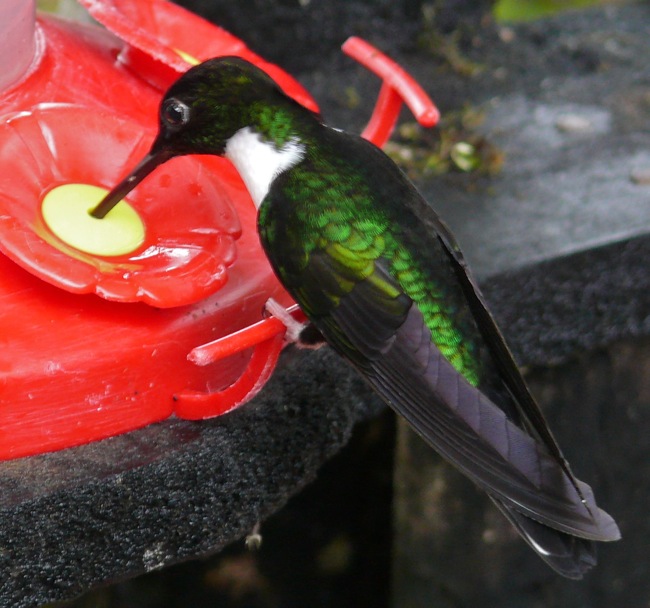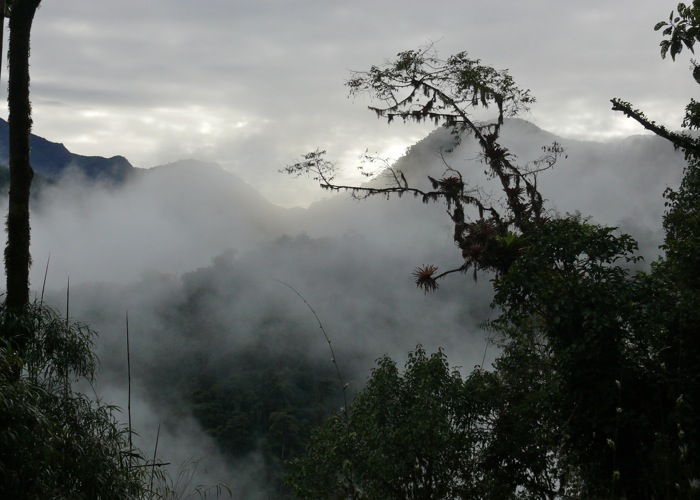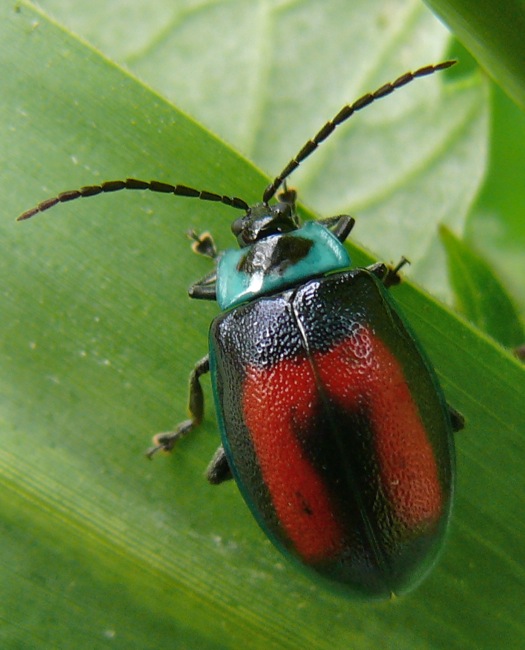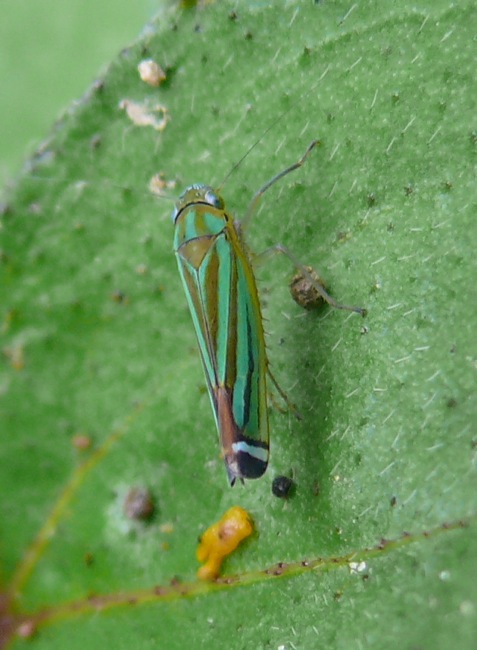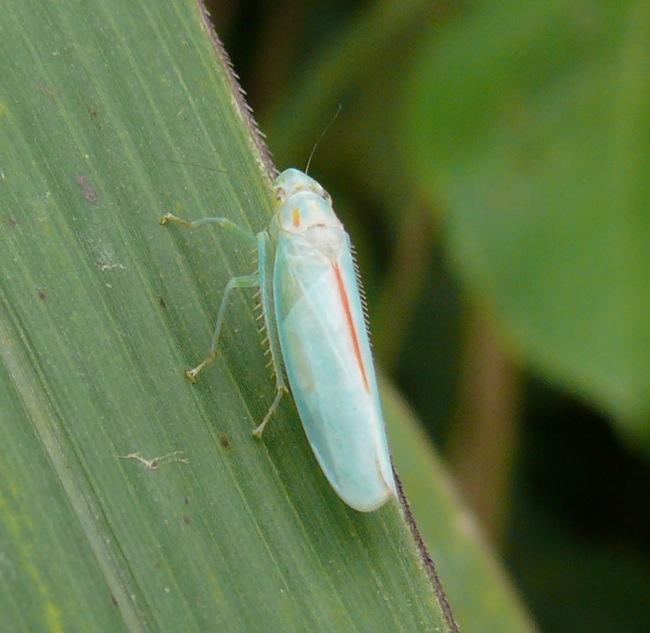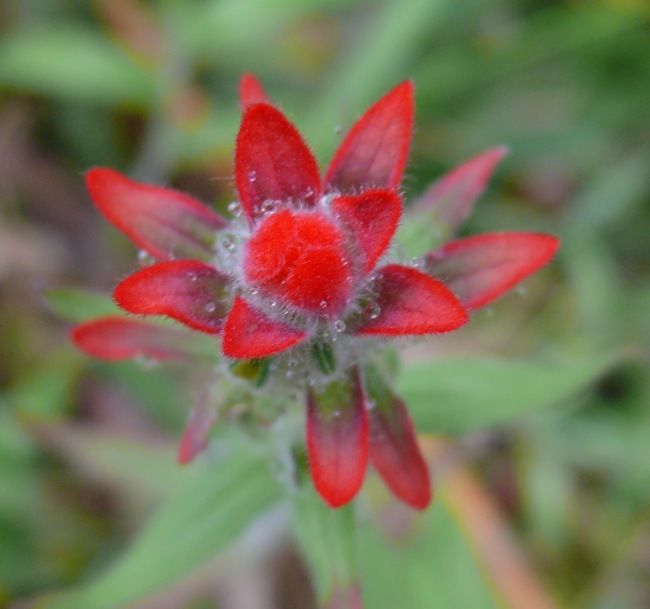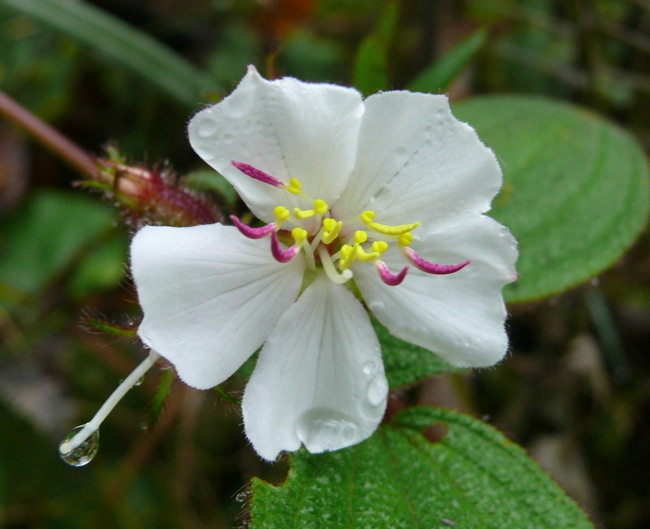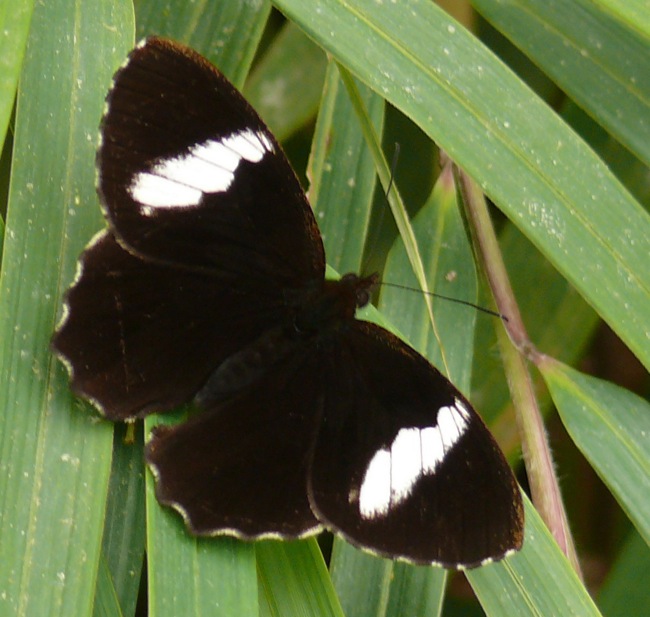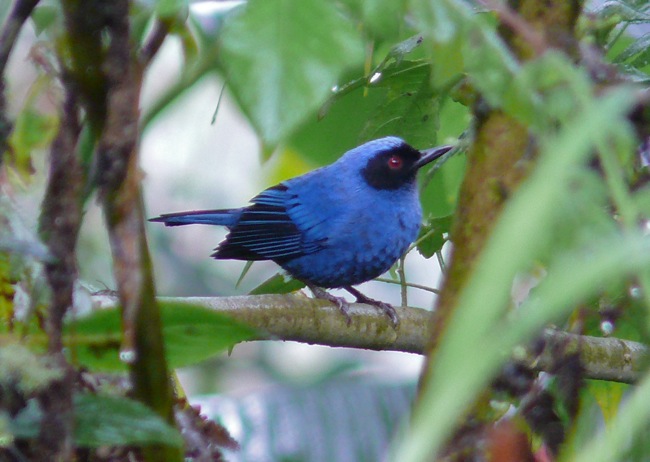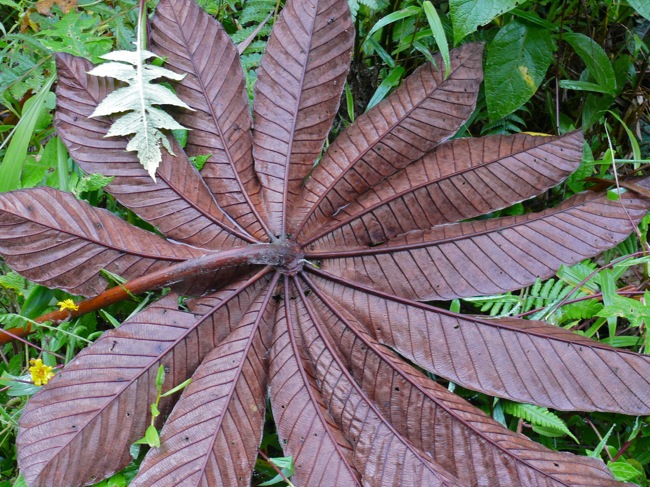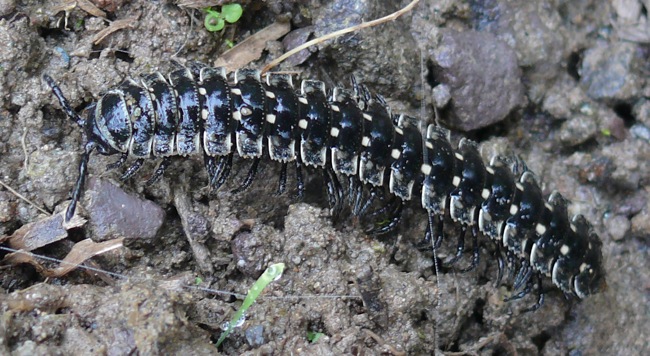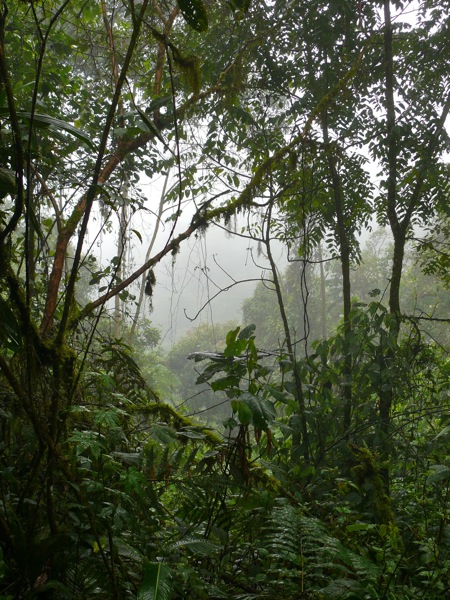Bellavista Cloud Forest Reserve is on the equator, between about 5,000 and 8,000 feet; a 2 hour drive west of Quito. When the warm air from the ocean hits the mountains, it rises, and as it cools, it condenses and turns to clouds or rain. The area where it condenses is called the cloudforest. It was cloudy or rainy, and cool most of the time we were there. There were a few moments of sun, but they didn’t last long.
It’s a spectacular spot – very thick lush vegetation, bright colored flowers, and birds everywhere.
This photo was taken out the window on the way from Quito to Bellavista. Quito is drier than Bellavista, and the mountains around it have houses and farm fields.
As the road wound up through the mountains, the clouds came in and it started to rain. This is Bellavista.
The building where we stayed – our room was on the first floor, on the left.
Our balcony – looking out into the forest.
The lodge is several buildings, connected by a walkway.
This is the building with the office and the bar.
Some of our dinner companions
Francisco and Marcie – working on some plant IDs
Mostly we were in the clouds, but once in a while the clouds lifted and we could see the mountains, including a volcano, on the other side of the valley.
We spent lots of time walking along trails through the forest. This is Francisco, our guide. He was fantastic – very knowledgeable about plants and birds.
Tree ferns
There are all kinds of odd looking flowers. This is a flower in the Arum family – Araceae – the same family as Jack-in-the-Pulpit.
Francisco
Every surface in the forest is covered with epiphytes – plants that grow on other plants. They get their nutrients from air and clouds and rain, and from particles that collect in crevices within reach of their roots.
One of the many orchids that grow in the cloud forest. This one is an Odontoglossom sp. – probably O. cirrhosum. (The IDs for these orchids are thanks to Otto Gockman.)
Maxillaria sp. – possibly Maxillaria lepidota.
Another orchid – Epidendrum sp. – possibly Epidendrum archnoglossum.
This is an odd, green orchid that was growing on the ground next to the path. Otto is working on an ID for it.
A closeup of the flowers
The trees in the cloud forest are very tall, and with all the dense vegetation – leaves and moss and epiphytes – not much light makes it down to the forest floor. Many of the flowers that bloom in that dim light are bright red – to catch the attention of the hummingbirds which pollinate them.
The clouds lifting a little.
David – he was working in the office while we were there, but usually he’s a guide.
Everyone took photos along the trails.
Bomarea sp.
More red hummingbird flowers
Aster family
Francisco called these “Inca Earrings”.
Crimson-mantled Woodpecker
A bromeliad – in the family Bromeliaceae – a huge family of plants in the tropics. Many bromeliads are epiphytes.
Blue-winged Mountain Tanager
In the southern U.S. the plants hanging from the trees are called Spanish Moss – but they’re actually bromeliads – not mosses. In the cloud forest, the moss-like plants hanging from the trees are actually mosses.
Mosses grow on every possible surface – this is the stem of a vine.
The trunk of a tree with vines and ferns growing out of the moss.
A small flower in the Aster family
A very muddy trail. The lodge provided rubber boots, and we really appreciated them.
We didn’t see many mammals – this squirrel was under the birdfeeders near the lodge.
Bromeliad epiphytes
These plants have flowers that hang below the leaves – so the red that attracts the hummingbirds is only on the underside of the leaves.
More epiphytes
An epiphytic bromeliad in bloom
The lodge has little lights along the walkway between the buildings that stay on all night. During the night, moths are attracted to the lights, and the trogons have learned that they can come by in the mornings and eat the moths. This is a male Masked Trogon.
The female Masked Trogon
Here are a few of the moths I saw. (To see more of the moths, go to my South American Moths post.)
This is a kind of Tiger Moth
Sphinx Moth
Tiger moth
Unidentified moth
A moth in the family Alucitidae. The ribs in its wings are like tiny feathers.
Unidentified moth
Another interesting insect that came to the lights
More trails in the rain
On one of the walks we saw an owl – one of the two tiny owls that live in this area: either a Cloud-forest Pygmy-Owl or an Andean Pygmy-Owl. It was very small – about 6 inches high – sitting on a branch watching us. It sat still and watched for a minute or so, and then flew.
This is the drip tip on a leaf. Many species have these pointed tips on their leaves, to help direct the water off of the leaves. The longer the water stays on the leaf, the more chance there is that something – either another plant or an animal or an insect – will start living there.
There are so many ferns, all different shapes and sizes. This is a fern frond unfurling.
Another fern
Another fern with an unusual shape
The fronds unfurling
A tree fern
Roots covered with moss stretch across the paths.
The forest is so thick that it would be very difficult to walk through without paths.
Tradescantia sp.
Another very tiny flower that I can’t identify
There are lots of hummingbird feeders around the lodge. This is the largest group of feeders and it’s always buzzing with activity. Francisco said that there are about 12 different species of hummingbirds that come to these feeders. (In Wisconsin, we have only one species.)
I took photos of all the species I saw, and asked Francisco to identify them for me – so I think these are all identified correctly.
Violet-tailed Sylph
Andean Emerald
Sparkling Violet Ear
Booted Racket-tail
Buff-tailed Coronet
Another Buff-tailed Coronet – showing its iridescent head. When it turned the right way, its face would light up with bright iridescent green.
Speckled Hummingbird
Gorgeted Sunangel
Collared Inca
This was a common beetle on plants growing by the side of the road.
A couple of beautiful little hoppers
A skipper (butterfly)
A species of Indian Paintbrush – Castilleja sp.
Unidentified flower
A Peucestas Satyr – I think – Pedaliodes peucestas
One of the Sisters buttterflies – Adelpha sp.
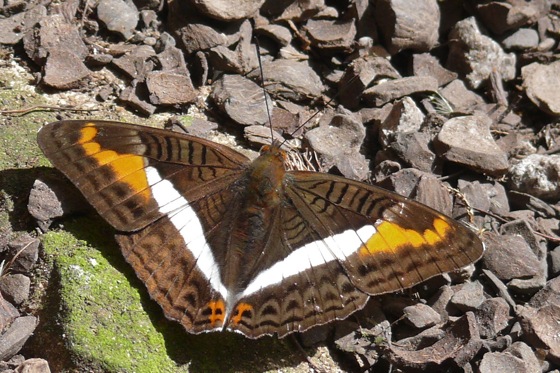
Masked Flowerpiercer – came to the nectar feeders
A leaf from a Cecropia tree.
A large millipede

